JARS v63n2 - The 2008 New Zealand Rhododendron Conference
The 2008 New Zealand Rhododendron Conference
Norma Senn
Victoria, British Columbia
Canada
When you're a "rhodoholic," spring can't come often enough. The solution? Go to New Zealand (NZ) in
October and November. Mary Berg, Nancy Moore and I, all members of the Fraser South Rhododendron
Society (FSRS), did just that in 2008. While there, along with several other ARS members, we
attended the New Zealand Rhododendron conference and then visited many lovely gardens around the
South Island on a tour organized by Diane Weissman, De Anza Chapter.
This year, the NZ conference was held in Geraldine on the South Island. Their conferences are a
bit different than the usual ARS ones in that the New Zealand conferences are spent touring gardens.
Every morning, everyone gathered at Woodbury Hall, just outside Geraldine to board the buses for
the day. We returned to Woodbury Hall for meals, the banquet and for the one talk presented at the
conference. Funnily enough, the presentation was by Richie Steffen about Seattle's Elizabeth C.
Miller Botanical Garden. The Miller Garden has the reputation of being a local Seattle jewel, but
only allows a small number of visitors to visit each year. Richie gave the three FSRS group the inside
"scoop" on how to make sure we get a chance to arrange a visit when we're next in Seattle. Isn't it
always the way? We go half way around the world and end up learning about something in our own
backyard.
In addition to using Woodbury Hall, the NZ conference organizers used white marquee-style tents to
house the truss show. The tents provided soft, diffused light which showed off flower colour very
well and made taking photos easy. The tents also remained cool which helped keep the trusses fresh
throughout the conference.
The conference program included visits to twelve gardens, and I'd be hard- pressed to pick just one
as my favourite. They were all lovely, and ranged from a couple of relatively new suburban gardens
to large country gardens. The large gardens were, for the most part, established decades ago to
surround the farmhouse of working sheep stations. Fortunately for my pocket book, I couldn't buy
any plants, but lots of the New Zealanders did when we visited Woodbury Rhododendron Nursery. The
bus drivers were very gracious in helping people load their purchases into the storage units under
the buses.
In most of the gardens we visited, the topography was rolling, allowing changes in elevation
throughout the gardens and lovely views of the surrounding countryside. Often, rhododendrons were
planted on steep terrain, providing them with excellent drainage although planting must have been
a challenge. Also in most places, some sort of water feature was present, usually a natural stream,
which added to the charm of the gardens.
As long as plants can be protected from the wind, it seems like anything can grow somewhere in New
Zealand. The "Southerlies" are cold winds that originate in Antarctica and these sweep over the
South Island frequently. For protection, large, dense windbreaks have been planted throughout the
South Island. Numerous species are used for windbreaks, but particularly common are Monterey pine
(Pinus radiata) and Monterey cypress (Cupressus macrocarpa). Around the "stations"
we visited, woodlands had also been planted early on, and we saw lots of mature oaks, elms,
beeches, maples, Douglas-fir (Pseudotsuga menziesii), Chamaecyparis and some
Thuja. We were told that both Monterey pine and Douglas-fir have become a bit of a problem
in some areas, and steps are being taken to control their spread into grazing lands. Considering
that NZ was colonized just over 150 years ago, the size of the trees is amazing, but growth rates
there are phenomenal. Shrubs and herbaceous ornamentals also grow quickly once shelter is available.
In the Orari Garden, as Nancy said, they were just showing off when they stated that Cardiocrinum
(giant lilies) had become a ground cover.
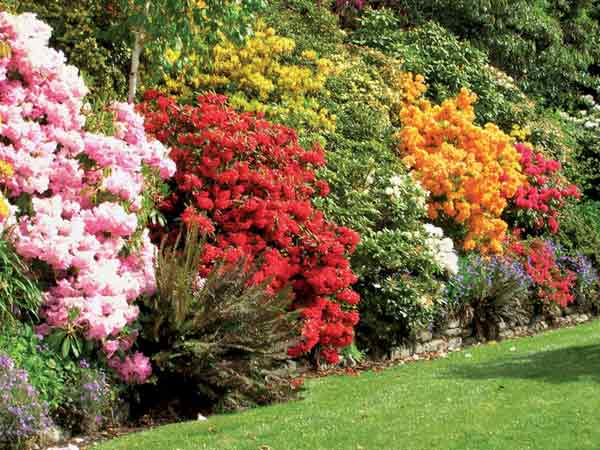 |
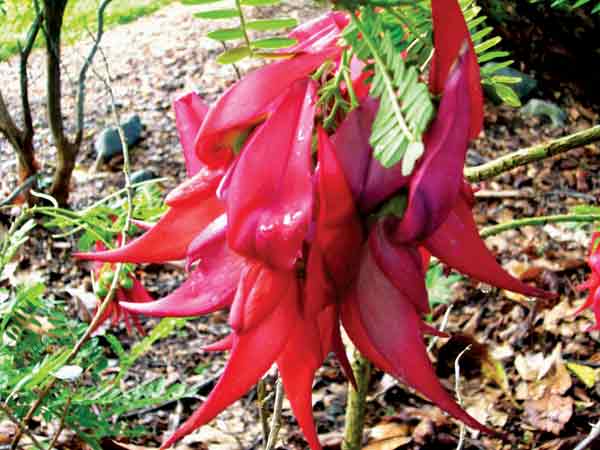 |
|
| Orari Gorge, home of Rosa and
Graham Peacock. Photo by Norma Senn |
New Zealand native plant
Clianthus puniceus (parrot-beak), Orari Gorge Photo by Norma Senn |
Many of the popular rhododendron hybrids grown in New Zealand would be easily recognized by ARS members; for example, most gardens we visited had 'Mrs. G.W. Leek', a whole host of Loderis, and 'Lem's Cameo'. Also popular were 'Horizon Monarch', 'Pink Pearl', 'Taurus', 'Scarlet Wonder', 'Pink Petticoats' and 'Fastuosum Flore Pleno'. Of course, there were also loads of lovely New Zealand hybrids - some we grow in British Columbia (BC), but some I hadn't seen before. 'Kiwi Magic' [(degronianum var. yakushimanum x 'Dido') x 'Lem's Cameo'] is certainly a sensational plant, with frilly flowers changing from deep pink in the bud through soft pink to pale yellow over time. I was also pleased to see lots of 'Rubicon' ('Noyo Chief' x 'Kilimanjaro'), although in most cases, this gorgeous red flowered rhody was just past its peak, leading to our hosts using that popular garden phrase, "you should have seen it last week!"
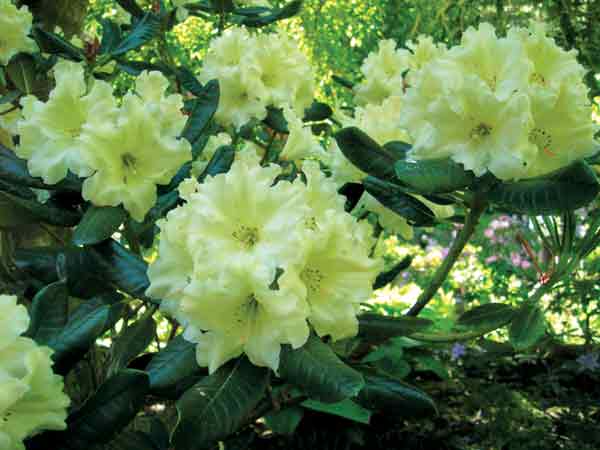 |
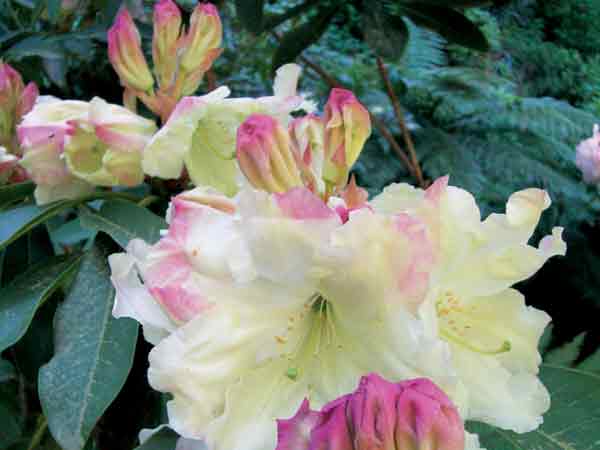 |
|
| Rhododendron 'Kiwi Pearl'. Photo by Norma Senn |
Rhododendron 'Ilam Cream'. Photo by Norma Senn |
A few other plants that I hadn't known before that I thought were terrific were: 'Ilam Cream', 'Ilam Cerise', 'Michael's Pride', 'Lemon Lodge' and 'Floral Dance'. I kept picking these beauties out every time I saw them. Here we know 'Ilam Violet' ('Electra' x russatum), but there are lots of other hybrids grown in New Zealand that carry the "Ilam" name. Both 'Ilam Cream' and 'Ilam Cerise' are large plants with large flowers. 'Ilam Cream' is a Loderi cross that starts pink in the bud and then opens to rich, creamy-white flowers that are tinged with pink at the edges of the flower lobes. These flowers have the added bonus of fragrance. 'Ilam Cerise' is a cross of 'Lady de Rothschild' x arboreum and is truly cerise coloured. The plants I saw were loaded with flowers and looked particularly nice when back lit. These are old hybrids, and have the reputation of being difficult to propagate, so are usually grafted. 'Michael's Pride' (burmanicum x dalhousiae) is tender with large, scented flowers, similar to 'Mi Amor'. It was at its peak of bloom while we were there. It has large fragrant flowers, yellow in bud and as they open, the flowers gradually change from yellow to a creamy colour. For us in or near Vancouver, BC, it would definitely need to be over-wintered in a greenhouse, but it just knocks your socks off! 'Lemon Lodge' ('Prelude' selfed) has fairly large primrose-yellow flowers in an open truss with nice medium green leaves on a good size plant. 'Floral Dance' (nuttallii x edgeworthii) shows its R. edgeworthii parentage with bright green rugose leaves. The prominent flower buds are bright pink and open white with deep pink edges. As you might expect with its parentage, flowers are scented and the plant might not be hardy outside in BC, but it's a beauty.
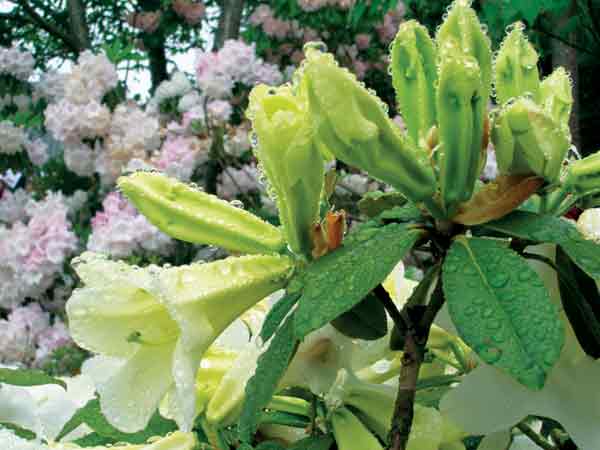 |
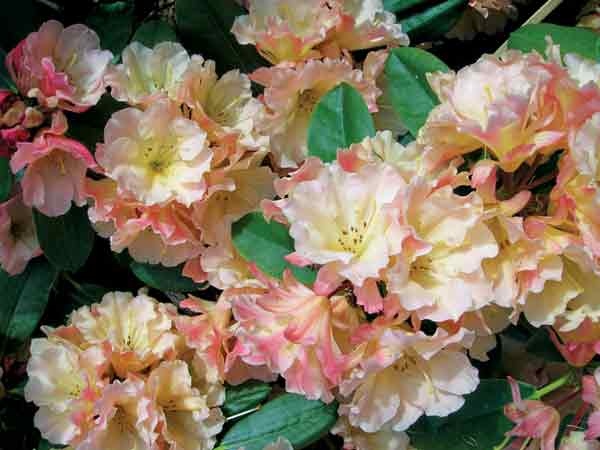 |
|
| Rhododendron 'Michael's
Pride' Photo by Norma Senn |
Rhododendron 'Kiwi
Magic' Photo by Norma Senn |
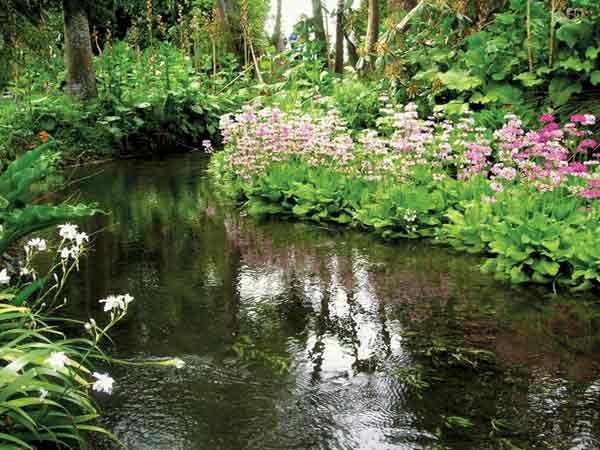 |
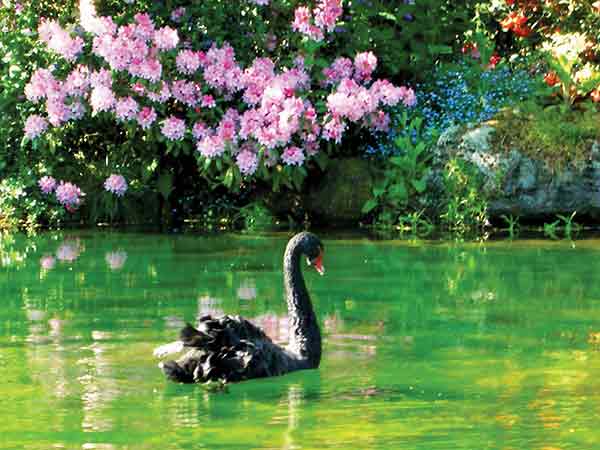 |
|
| Primula at Orari Estate, home
of Rosie and Ian Morten. Photo by Norma Senn |
The Capricorns, home of Rosa
and Philip Burdon. Photo by Norma Senn |
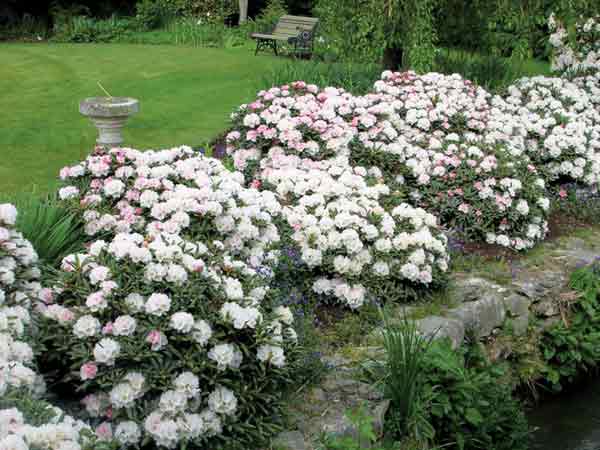 |
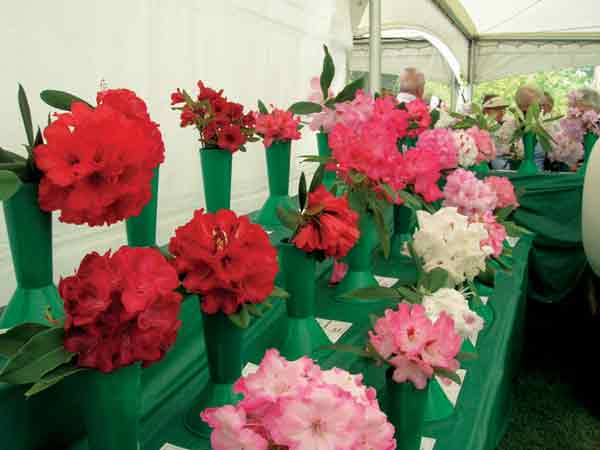 |
|
| Rhododendron yakushimanum
at Travenna Gardens, home of Margaret and Murray Turley. Photo by Norma Senn |
Conference truss
show. Photo by Norma Senn |
The deciduous azaleas were also outstanding, and they had the most unbelievably intense,
glowing floral colours. In talking with some of the New Zealand folks, I was told that one theory
to explain the depth of colour was that because of the Southern Hemisphere hole in the ozone
layer overhead, ultraviolet light is exceptionally high and this contributes to floral pigment
intensity. The intense floral colours weren't limited to azaleas, as all flowers seemed to be just
that much more colourful than what we see in North America.
It was interesting to see that at least for the gardens we visited as part of the conference,
there weren't many Rhododendron species planted. We did see some R. macabeanum,
a few R. augustinii, and R. arboreum, and occasionally a few other species, but they
weren't common. I have the impression that in the Pacific Northwest, we use more species in our
average home rhododendron gardens than the New Zealanders do. Perhaps this is due to our relatively
close proximity to the Rhododendron Species Foundation?
On a slightly silly, but very practical note, one of the ideas we could borrow from the New Zealand
conference is their use of portable potties. Someone had the bright idea of putting four
"port-a-potties" on a trailer and then trucking the trailer around to each of the locations where
the activities were in session. This meant that individual garden owners didn't have to cope with
300 people all in need of a comfort stop at the same time. Keep in mind, we were given tea,
coffee and wine regularly at many of the gardens, so the portable potties got a lot of use!
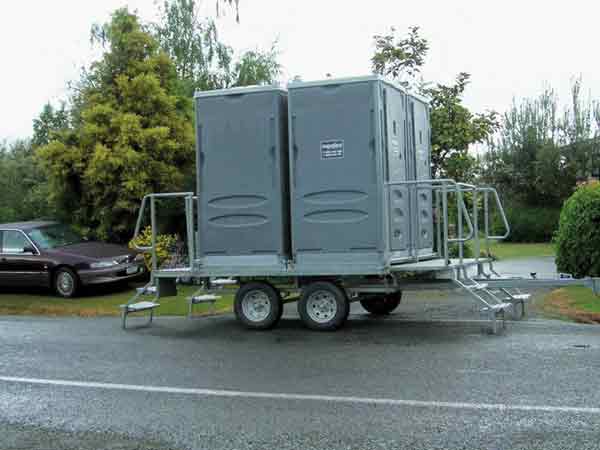 |
| Outhouse on wheels. Photo by Norma Senn |
The conference was well-organized, and we were warmly welcomed by the New Zealanders. We enjoyed ourselves so much, and the gardens and plants were fabulous. If you haven't had the chance to visit New Zealand, you must add it to your places to visit. Next year, the conference will be in Auckland, so if you are interested in vireyas or maddenias, this will be the place to go.
Norma is now a member of the Victoria Chapter, but was a Fraser South (FS) Chapter member until her recent move to Victoria. While with that chapter, she and two other FS members, Mary Berg and Nancy Moore, attended the New Zealand Rhododendron conference and then toured many other lovely gardens around the South Island.